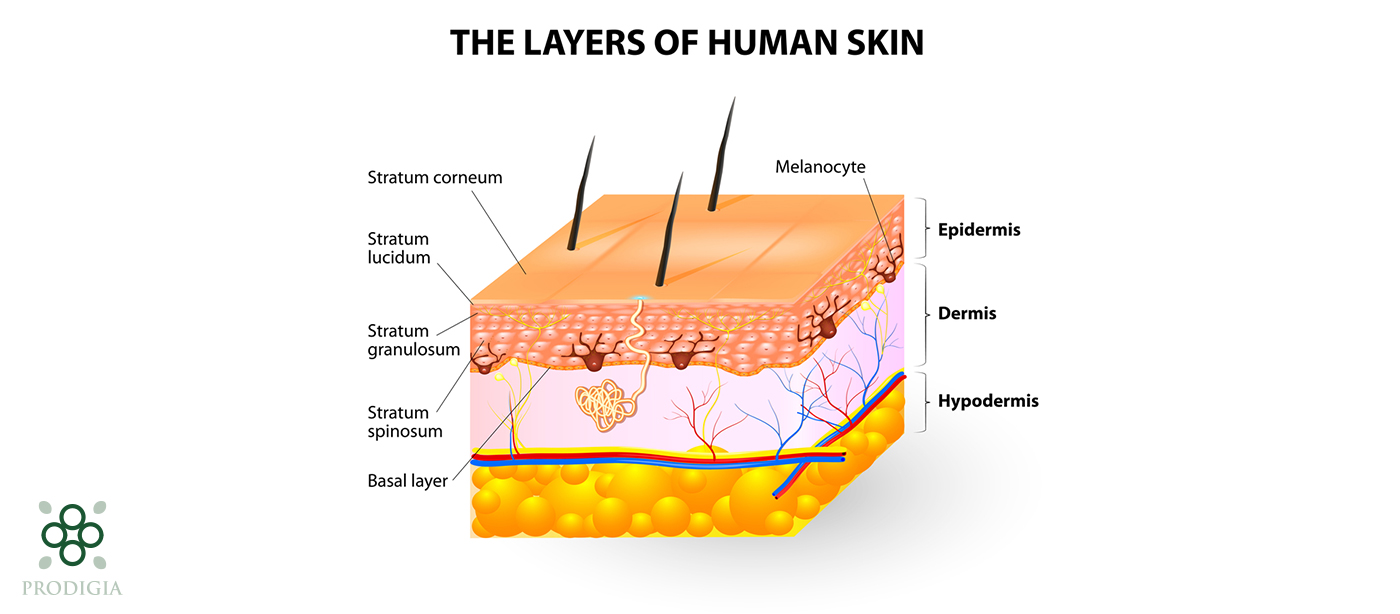Cosmetic products are an integral part of our daily lives, but few consumers are aware of the mechanisms that allow the skin to absorb them. In this article, we will explain these mechanisms and we will shed light on the factors influencing the absorption of cosmetics by the skin, and finally we will explore some safe and legal perspectives:
1. Understanding the absorption of cosmetics by the skin:
The skin: a protective barrier and an organ of absorption: More than a simple envelope, the skin is an organ in its own right. Its mass and surface area are the largest in the body. It protects other organs from infection, injury and harmful sun rays. It is therefore a real interface with the outside world.
What are the barriers of the skin? The skin consists of three main layers: the epidermis, the dermis and the hypodermis. The outermost layer of the skin, called the epidermis, forms a protective barrier against external influences. The outer layer of the epidermis, called the horny layer or stratum corneum, is made up of dead cells contained in epidermal lipids and is covered by the hydrolipidic film which includes the acid mantle. It is the epidermal lipids that are responsible for binding moisture and creating a skin permeability barrier, thus preventing bacteria and viruses from penetrating to the surface of the skin. Thus, the epidermis simultaneously plays the role of water, physical, chemical and antimicrobial barrier.
The absorption of cosmetics at the level of the stratum corneum: The stratum corneum or the stratum corneum, is the outermost cell layer of the epidermis, the most superficial tissue of the skin.
According to the 500 Dalton rule, the molecular weight of a compound must be less than 500 Dalton to allow skin absorption at the level of the stratum corneum. Larger molecules cannot pass through the corneal layer.
The different skin absorption routes of cosmetics:
Initially, the active ingredient must absolutely bind to the stratum corneum by dissolving in its surface hydrolipidic film. Then it crosses this barrier in two possible ways: absorption either by the stratum corneum or by the cutaneous appendages. In the majority of cases, these two passageways are used simultaneously
The passage through the stratum corneum: The stratum corneum is a multi-layered area made up of dead cells. The passage through the stratum corneum can be carried out by the trans-cellular and intercellular route.
- The transcellular route: The active ingredients contained in beauty products pass from cell to cell provided that they are small in size OR that they are hydrophilic, i.e. they have an affinity for the water present in the well hydrated stratum corneum leading to make them soluble.
- The intracellular pathway: Between cells, the pathway most often used. The lipophilic active ingredients (which retain fatty substances) circulate in the inter-lipid cement which ensures the cohesion of the cells of the horny layer, then in the interstitial liquid which fills the spaces between the cells of the deeper layers of the skin.
The passage through the cutaneous annexes: The pathway through the cutaneous annexes corresponds to passage through the pilosebaceous follicles (trans-follicular pathway), and much more rarely through the ducts of the eccrine sweat glands which secrete sweat. Although this pathway is in the minority, it presents a non-negligible possibility of storage and dissemination. The trans-follicular pathway allows molecules to penetrate to the reticular dermis.
2. Factors influencing the absorption of cosmetics by the skin:
Knowing how a beauty product is absorbed by the skin can largely prevent irritant reactions. Here are six factors that influence the absorption of active ingredients by the skin:
- In people over 60, hydrophilic active ingredients penetrate less because their skin is dehydrated.
- The site of application: The absorption of cosmetics by the skin is not the same in all parts of the body. For the same compound applied to two different anatomical sites, the penetration will be different. The thinner the stratum corneum (eyelids), the greater the penetration. On the contrary, the thicker it is (palms of the hands and soles of the feet), the less the penetration is important.
- The condition of the skin: The thicker and oilier it is, the less permeable it is. Thoroughly cleanse your skin and exfoliate to facilitate the penetration of cosmetic products. Irritated skin will be more permeable. The state of hydration of the skin is essential, the more it is hydrated the more it is permeable.
- The size and nature of the molecule that must cross the skin barrier: The smaller the molecule, the more easily it will penetrate. A hydrophilic molecule will tend to take the transcellular route and will only be able to cross if the skin is well hydrated.
- The form of administration of cosmetic products: This is the galenic form which corresponds to the final physical appearance of the product as it will be used (lotion, gel, mousse, emulsion, patch, etc.). The skin penetration of an active molecule varies according to the galenic form in which it is presented.
- Methods of application: The thickness of the layer of product applied to the skin and the frequency of application have an influence on the penetration of active ingredients. Indeed, the application of a thick layer of cream has an occlusive effect and will therefore improve absorption by the skin, this is the principle of masks. Similarly, applying a product to a larger area of skin promotes penetration.
At Prodigia, our formulas are composed of at least 95% natural ingredients and are developed in accordance with Cosmos standards.
Need advice? Contact Prodigia!



